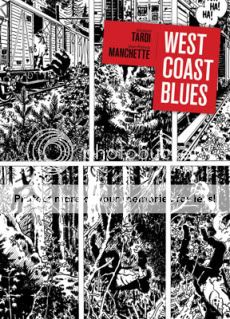West Coast Blues
Jacques Tardi, writer/artist
adapted from the novel by Jean-Patrick Manchette
Fantagraphics, 2009
pages, hardcover
$18.99
In a book like this, where a cartoonist is adapting a novel you haven’t read, it’s difficult to say who deserves credit for what. All I know is, someone deserves a lot of credit. As slim, smooth, and hard as its attractive, Adam Grano-designed album-style hardcover format, West Coast Blues is as strong a crime comic as you’re likely to see this year (or until whenever the next Gipi Wish You Were Here Ignatz book comes out). So maybe it’s weird for me to start by talking about the problems I had with it, but let’s get them out of the way: Certain basic character components are things you’ve seen many times before. There are hitmen who banter innocuously between dispassionate murder attempts, a torturer who loves his dog, and a protagonist who doesn’t seem attached to anyone but his own hide. Which is weird, since the protagonist, George, is just an average joe. Maybe there are people out there who, when suddenly targeted by murderers, would be able to ditch their families and entire lives without feeling much of anything about it, but I don’t think I know any, and I’m certainly not one of them. All I do is feel. Sometimes I think crime fiction would be a lot more effective if, as is often the case in real life, the crime really visibly fucked the victims up. (Though to be fair, there are other characters we come across for whom it’s done exactly that.)
What the book does right makes for a much longer list than what it does wrong. For starters, there’s Tardi’s art, a master class in spotted blacks and lines like garrote wire. Tardi juxtaposes cartoony figures against frequently photorealistic backgrounds and objects like a manga-ka, but his characters of a rubbery Rick Geary look that’s at once lighthearted and ugly. This makes them perfect vessels for the story’s sudden bursts of apocalyptic violence, which appear out of nowhere, rain mayhem all over a couple of pages, and then vanish like a summer storm, returning us to our taciturn hero and his quotidian environments. I think everyone will talk about the beach attack, for instance–how well Tardi conveys a Jaws-like seashore scene so sunny and crowded with swimmers that a man could be assaulted and drowned without even those closest to him realizing that anything was going on but horseplay. It was a stroke of genius for this to be the first big setpiece, sending the message that bad shit could go down anytime, anyplace. Just as impressive, and just as well-choreographed from an action perspective, is the book’s central one-two-three punch: a chaotic shootout, an assault by a ghoulish hobo, and the tumble from a train through a seemingly Mirkwood-like forest that’s seen on the book’s cover. After a prolonged period of Godot-like waiting for something to happen, it all seems to happen at once, leaving both George and the viewer dazed and confused amid Tardi’s riot of a woods. George emerges from the other side of this sequence as another person, in a literal sense, and it’s such bravura storytelling we can innately understand why.
The end of the book (and the beginning) seem to want to raise bigger questions than the basic plot–essentially, “no good deed goes unpunished”–would appear to offer. I suppose it’s to Tardi and Manchette’s credit that they try to address my complaint about George’s weird stoicism more or less head on, though I’m not sure I buy their explanation. But it left me thinking, I’ll give them that, and a book that can leave me thinking after keeping me turning the pages as fast as I can is a book that got it done if you ask me. I even liked how people’s howls of pain were simply portrayed as giant letter A’s. This sucker’s good.
Tags: comics, comics reviews, Comics Time, reviews


Pingback: Comics Time: Like a Sniper Lining Up His Shot « Attentiondeficitdisorderly by Sean T. Collins